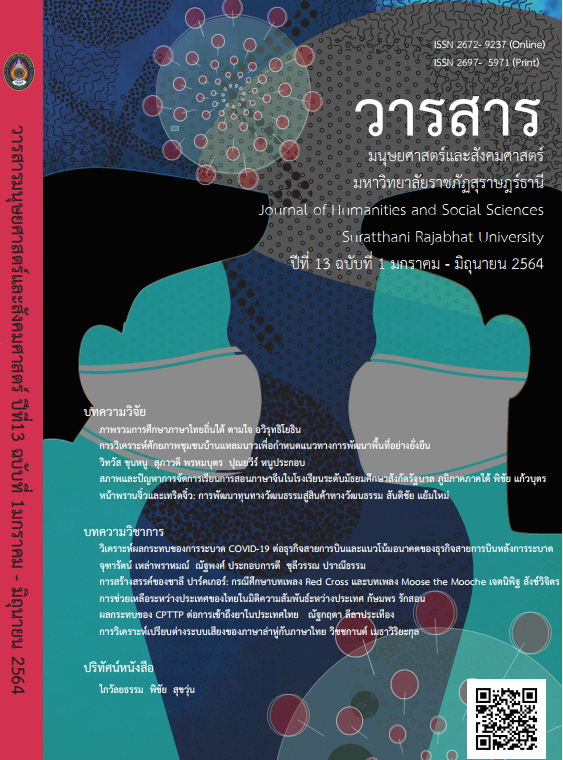การช่วยเหลือระหว่างประเทศในมิติความสัมพันธ์ระหว่างประเทศ
Main Article Content
บทคัดย่อ
บทความนี้มุ่งเน้นการศึกษาการช่วยเหลือระหว่างประเทศของไทยในมิติความสัมพันธ์ระหว่างประเทศ จากการเปลี่ยนแปลงของระบบโลกในด้านของอำนาจทางเศรษฐกิจ สังคม การเมือง นำไปสู่การพัฒนาประเทศอย่างไม่เท่าเทียมกันระหว่างรัฐ การช่วยเหลือระหว่างประเทศจึงกลายเป็นเครื่องมือของรัฐที่มีอำนาจมากกว่าโดยหยิบยื่นความช่วยเหลือเพื่อการพัฒนาให้แก่รัฐที่อ่อนแอกว่า เช่น ในกรณีเกิดปัญหาความยากจน ภัยพิบัติ โรคระบาด หรือการถ่ายทอดทางเทคโนโลยี ความช่วยเหลือจากต่างประเทศ ถูกจัดสรรในลักษณะเงินให้เปล่า เงินกู้ หรือเป็นการให้สิ่งของ ผลกระทบจากการช่วยเหลือระหว่างประเทศนำไปสู่การพัฒนาทางเศรษฐกิจในภาคการผลิตและการจ้างงานที่เพิ่มขึ้น การลดปัญหาความยากจน และเสริมสร้างความสัมพันธ์อันดีทางด้านการทูตระหว่างรัฐ ประเทศไทยสามารถสร้างพันธมิตรและสร้างความสัมพันธ์อันดีกับรัฐเพื่อนบ้านได้จากการให้ความช่วยเหลือระหว่างประเทศของไทยราวกับว่าเป็นเครื่องมือทางการทูตอย่างหนึ่ง แต่ทว่าในมุมมองของประเทศเพื่อนบ้าน ประเทศไทยแสดงบทบาทของ “รัฐผู้ให้ หรือ รัฐผู้บริจาค” ซึ่งบทบาทดังกล่าวอาจจะนำไปสู่จัดการแสวงหาผลประโยชน์ในด้านเศรษฐกิจจากรัฐผู้รับ
Article Details

This work is licensed under a Creative Commons Attribution-NonCommercial-NoDerivatives 4.0 International License.
ต้นฉบับทุกเรื่องที่พิมพ์เผยแพร่ได้รับการตรวจสอบความถูกต้องทางวิชาการโดยผู้ทรงคุณวุฒิ (Peer Peview) เฉพาะสาขามนุษยศาสตร์และสังคมศาสตร์ การตีพิมพ์บทความซ้ำต้องได้รับการอนุญาตจากกองบรรณาธิการเป็นลายลักษณ์อักษร
References
กรมความร่วมมือระหว่างประเทศ (2561). กระทรวงการต่างประเทศ. [Online]. เข้าถึง
ได้จาก http://www.tica.thaigov.net/main/th/aid/10737. [2562,
พฤษภาคม 22 ].
กรมประชาสัมพันธ์ (2561, ธันวาคม 14). นายกรัฐมนตรีนำคณะรัฐมนตรีร่วมการ
ประชุมร่วมนายกรัฐมนตรีและรัฐมนตรีไทย- ลาว อย่างไม่เป็นทางการ ครั้งที่ 3
เน้นความเชื่อมโยงในทุกมิติแบบไร้รอยต่อ. [Online]. เข้าถึงได้จาก http://
thainews.prd.go.th/th/website_th/news/news_detail/TN
POL6112140010006. [2563, สิงหาคม 16].
กรมเศรษฐกิจระหว่างประเทศ (2558). ยุทธศาสตร์ความร่วมมือทางเศรษฐกิจอิรวดี -
เจ้าพระยา - แม่โขง (ACMECS). [Online]. เข้าถึงได้จาก http://www.mfa.
go.th/business/th/cooperation/ [2563, สิงหาคม 16].
ข่าวสด (2561, กรกฎาคม 25). "รัฐบาลไทย" มอบ 5 ล้าน ช่วยชาวลาว หลังเขื่อนแตก
น้ำท่วมวิกฤต. [Online]. เข้าถึงได้จาก https://www.khaosod.co.th/
breaking-news/news_1374662. [2563, สิงหาคม 16].
ไทยโพสต์ (2561, กันยายน 3). จีนใจป้ำ เสนอเงินช่วยแอฟริกาอีก 1.9 ล้านล้านบาท.
[Online]. เข้าถึงได้จาก https://www.thaipost.net/main/detail/16737.
, มกราคม 24].
โพสต์ทูเดย์ (2558, กุมภาพันธ์ 25). ไทย-กัมพูชาร่วมพัฒนาหมู่บ้านตามหลักศก.พอเพียง.
[Online]. เข้าถึงได้จาก https://www.posttoday.com/social/
local/349623. [2563, สิงหาคม 16].
ว้อยซ์ ทีวี (2563, กรกกฎาคม 15). ครม.เห็นชอบปล่อยกู้เมียนมา 1,485 ล้านบาท แถม
ปลอดหนี้ 10 ปี. [Online]. เข้าถึงได้จาก https://www.sanook.com/
news/8208562/. [2563, สิงหาคม 16].
Alesina, A. and Dollar, D. (2000). Who Gives Foreign Aid to Whom and Why?.
Journal of Economic Growth. 5(1), 33-63.
Africa Hunger and Poverty Facts (2018). African page. [Online]. Retrieved
from https://www.worldhunger.org/africa-hunger-poverty-
facts-2018/. [2019, July 14].
Binagwaho, A. (2018). The Road Ahead for US Foreign Aid to Africa. [Online].
Retrieved from https://www.aspeninstitute.org/blog-posts/
the-road-ahead-for-us-foreign-aid-to-africa/ . [2019, October 21].
Breuning, M. and Ishiyama, J. T. (2003). Donor Characteristics and the
Dispersion of Foreign Assistance. International Politics. 40(2), 249-
Bueno de Mesquita, B. and Smith, A. (2011). The Dictator’s Handbook. New
York: Public Affairs Press.
Carr, E. H. (2001). The Twenty Years' Crisis. New York: Palgrave.
Glassman, J. (2011, April 8). Foreign Aid : The Good And Bad. Forbes.
[Online]. Retrieved from https://www.forbes.com/sites/jamesglassman
/2011/04/08/foreign-aid-the-good-and-bad/#47a67f887257.[2019, July 12].
Hook, S.W. and Zhang, G. (1998). Japan’s aid policy since the Cold War:
rhetoric and reality. Asian Survey. 38, 1051–1066.
Lancaster, C.(2007). Foreign aid: Diplomacy, development, domestic
politics. Chicago: The Chicago University Press.
Masud, N. and Yontcheva, B. (2005). Does Foreign Aid Reduce Poverty?
Empirical Evidence from Nongovermental and Bilateral Aid. IMF
Working Paper, WP/05/100. International Monetary Fund.
Meservey, J. (2020). China’S Palace Diplomacy in Africa. [Online]. Retrieved
from https://warontherocks.com/2020/06/chinas-palace-diplomacy-
in-africa/. [2020, August 14].
Morgenthau, H. (1962). A Political Theory of Foreign Aid. American Political
Science Review. 56(2), 301-309.
Nissanke, M. and Thorbecke, E. (2010). Linking Globalization to Poverty in Asia, Latin America and Africa. Policy Brief. [Online]. Retrieved from
https://www.wider.unu.edu/sites/default/files/PB2010-003.pdf . [2019,
July 21].
Niyonkuru, F. (2016). Failure of Foreign Aid in Developing Countries: A Quest
for Alternatives. Business and Economic Journal. 7(3), 2-9.
Quinn, J. and Simon, D. J. (2006). Plus ça change: The Allocation of French
ODA to Africa During and After the Cold War. International
Interactions. 32(3), 295-318.
Rajan, R. and Subramanian, A. (2005). Aid and Growth: What Does the
Cross-Country Evidence Really Show?. IMF Working Paper,
WP/05/127. International Monetary Fund.
Reci, A. (2014). Advantages and disadvantages of foreign assistance in
Albania. Forum Scientiae Economic. 2(3), 123-132.
Seo, H. (2017). Politics of Aid: A Closer Look at the Motives Behind Foreign
Assistance. Harvard International Review. 38(2), 42-47.
Tuman, J.P. and Ayoub, A. S. (2004). The determinants of Japanese official
development assistance in Africa: a pooled time series analysis.
International Interactions. 30, 45–59.

